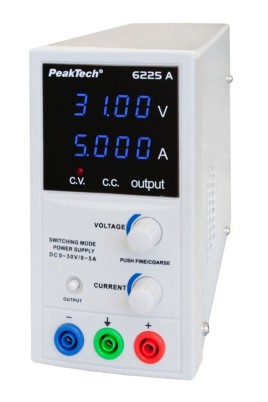Review: Bench-top Power Supply PeakTech PSU 6225A
November 14, 2019
on
on

The small form factor of this PSU was also a point in its favour as, due to space limitations in my lab, I prefer not-too-wide equipment. Depth, on the other hand, is plentiful. This PeakTech model is only 80 mm wide and 260 mm deep, a perfect fit for my lab. Compared to my old 5-kg or so PSU it is also much lighter as the PeakTech 6225 A only weighs 1.5 kg.
Power Button in the Back
Probably because assembly is easier and cheaper this way, the PeakTech PSU 6225 A has a power button at the back. This is not too practical if you ask me, but I can live with it because there is an output disconnect button on the front.Front Panel
Two clear blue 4-digit LED displays show the values of the output voltage and the current limit. These values are controlled with two rotary encoders below the displays.Three red LEDs indicate the operating mode of the PSU:
- Constant voltage (C.V.)
- Constant current (C.C.)
- Output (controlled by a pushbutton cleverly labelled ‘output’).
Operating modes
Constant voltage mode is how the PSU is probably used in most cases, at least for me: an adjustable power supply to power all sorts of circuits under test with the current limit set to a safe value. As soon as the load demands more current than available, the PSU will enter C.C. mode. When this is unwanted, due to a short circuit for instance, this mode may avoid damaging components. When charging batteries this mode will limit the charge current to a safe value.Read full article
Hide full article


Discussion (0 comments)